Are you considering adding more plants to your aquarium? If so, you may have heard that overcrowding your aquarium with plants can be useful. But did you know that it can also be dangerous? As an expert on aquatic plants, I’m here to tell you all about the risks, benefits, and solutions when it comes to overcrowding your aquarium with plants.
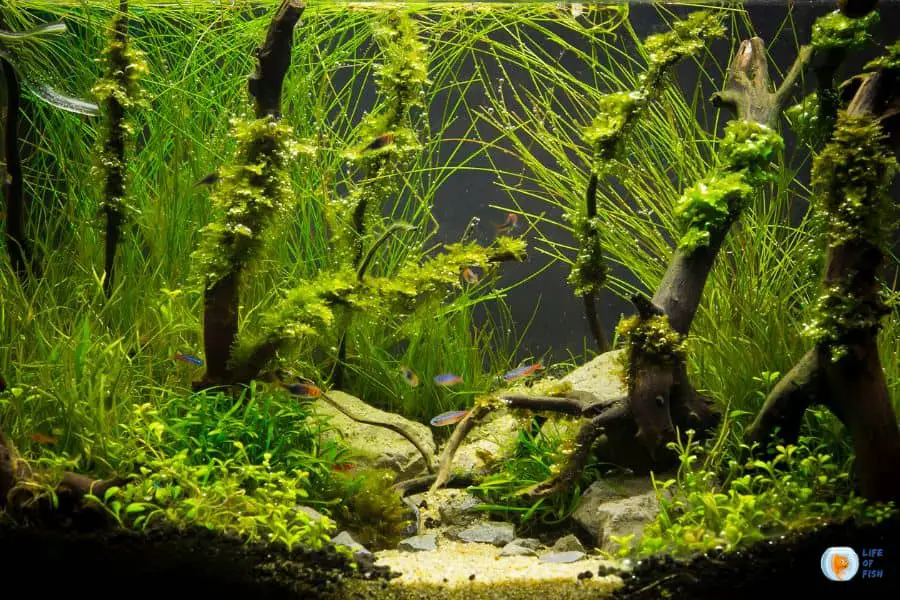
In this article, we’ll discuss how too many plants can cause oxygen depletion and water quality issues. As well as how overcrowding can benefit your fish’s health and provide shelter for them. We’ll also give some tips on how to avoid overcrowding in order to keep your aquarium healthy and balanced.
So if you’re looking for a way to bring more life into your tank without risking its safety, read on! You’ll learn everything you need to know about overcrowding your aquarium with plants so that you can make a good decision.
What is an overcrowded planted aquarium?
Jump To
- 1 What is an overcrowded planted aquarium?
- 2 Pros And Cons Of Overcrowding
- 3 Different Types Of Aquarium Plants
- 4 Impact On Filtration System
- 5 Light Requirements For Plant Growth
- 6 Nutrient Levels In The Water
- 7 Algae Growth And Competition
- 8 Fish Health Concerns
- 9 Plant Selection Criteria
- 10 Proper Planting Techniques
- 11 Pruning And Maintenance Tips
- 12 Choosing The Right Number Of Plants
- 13 Compatibility With Other Aquatic Life
- 14 Alternatives To Overcrowding
- 15 Maintaining Balance In The Aquarium
- 16 Conclusion
Aquarium overcrowding is when too many plants are placed in an aquarium, resulting in unhealthy growth. This overcrowding can lead to a variety of risks, including diminished water quality, not enough oxygen levels, and increased algae growth.
It can also cause problems with the filtration system, leading to more frequent water changes and maintenance. Despite these risks, there are some benefits that come with aquarium overcrowding. These include providing more surface area for good bacteria to colonize, improving water quality and clarity, and creating a lush landscape that looks visually appealing.
To avoid the risks associated with overcrowding while still reaping the benefits it brings, proper planning is important. One solution is to ensure that there is a lot of space between plants to make sure they have enough room to grow without competing for resources like light or nutrients. Additionally, it’s important to research specific species before adding them to your aquarium so you know how fast they grow and what kind of environment they need in order to thrive.
Pros And Cons Of Overcrowding
When done correctly, overcrowding a tank can have some great benefits. To start, it creates an beautiful environment with a variety of colors and textures. Furthermore, overcrowding can provide good shade for fish and aquatic life living in your tank. Lastly, it can increase oxygen levels and help to balance out temperature fluctuations.
However, overcrowding should be approached cautiously as there are risks associated with it as well. Too many plants in a single aquarium can lead to competition for nutrients and space which could cause some plants to die off. Additionally, overcrowded tanks may require more frequent maintenance such as cleaning algae or trimming dead or dying leaves from the plants.
Pros of Overcrowding:
- Creates a beautiful environment
- Provides good shade for fish and aquatic life
- Increases oxygen levels and helps balance out temperature fluctuations
Cons of Overcrowding:
- Competition for nutrients and space leading to plant death
- More frequent maintenance due to algae build up or dead/dying leaves
- Accumulation of toxins harmful to aquatic life
If done right, this practice can create a beautiful display that also provides a safe habitat for all its inhabitants!
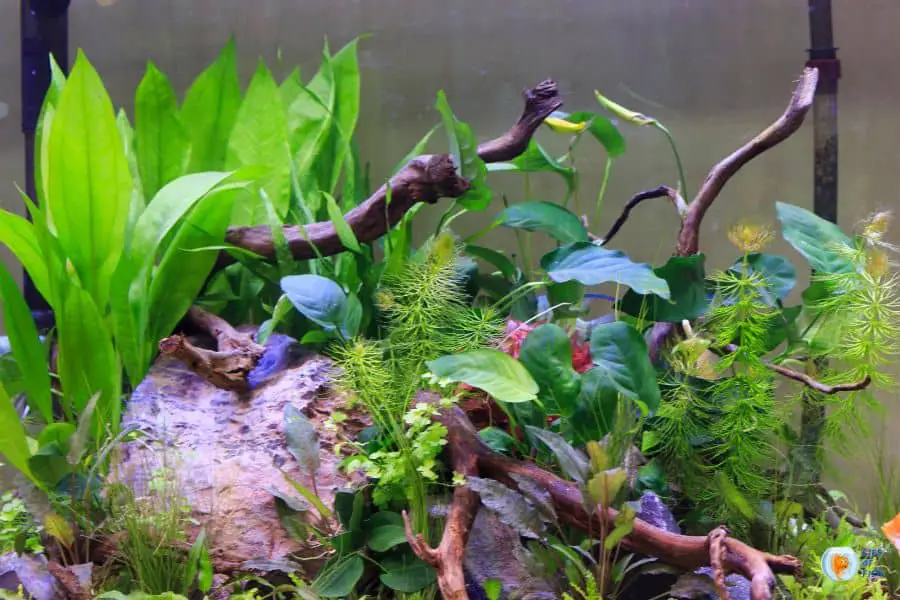
Different Types Of Aquarium Plants
There are four main types of aquarium plants: substrate-rooted, pond-plants, floating-leaved and oxygenating plants.
- Substrate-rooted plants have their roots in the bottom substrate of the tank and they’re usually taller than other types of plants.
- Pond-plants are usually short and low growing, but some varieties can reach heights of up to 12 inches.
- Floating-leaved plants are fast growers, producing a lot of shade for fish that need it. They also help reduce algae growth by competing with it for nutrients in the water column.
- oxygenating-plants are small stem plants that produce oxygen and help maintain a healthy environment within an aquarium. They also provide food for fry (young fish) through their root systems.
It’s important to research each type of plant before adding them to your tank, as some may not be suitable for your specific setup or desired outcome.
Impact On Filtration System
When overcrowding an aquarium with plants, it is important to understand the impact this could have on the filter system. A filtration system plays a vital role in keeping a healthy balance of water parameters in an aquarium. And overstocking with plants can have adverse effects on this process. Excess plant matter can clog up the filter, leading to poor water circulation and poor filtration. This can cause oxygen levels to drop, resulting in fish stress and illness.
To prevent filter system issues it is important to choose an appropriate aquarium filtration system for your tank size and stocking levels. Keep the filter clean by regularly replacing media and cleaning out debris so that there are no blockages or clogs. Consider adding additional filters or increasing flow rates if necessary. Additionally, use a good substrate that will help to keep the tank clean while giving important nutrients for your plants. By following these steps, you will ensure your aquarium filtration system is able to do its job effectively, even when dealing with heavy plant populations.
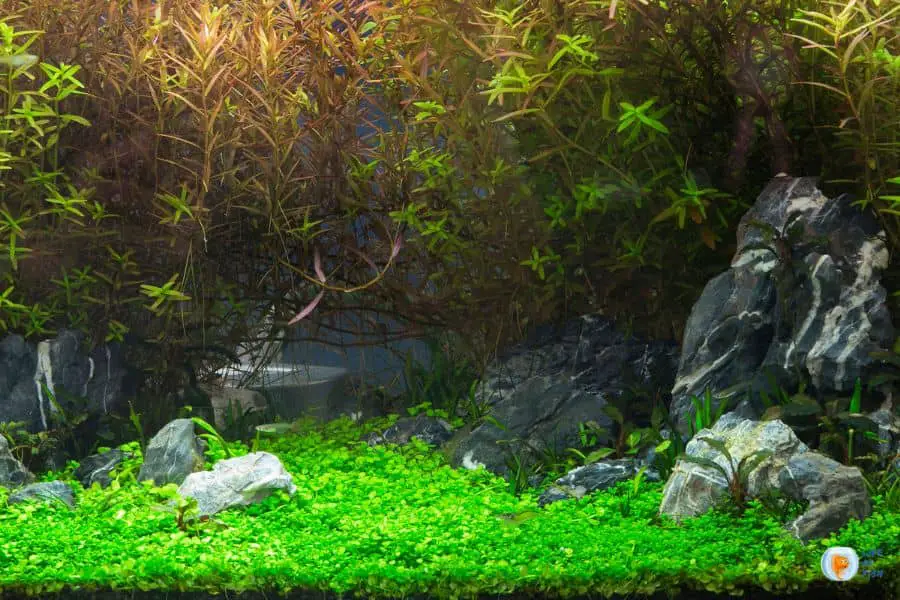
Light Requirements For Plant Growth
Light is an essential element for aquatic plants and animals living in the aquarium. Without proper light, plants can’t photosynthesize and aquatic life can’t survive. Aquarium lighting requirements are different for each plant species. But most require a full-spectrum light that provides a balance of blue and white wavelengths. The intensity of the light will determine how much photosynthesis the plant will be able to perform. Without enough light, photosynthesis may not occur at all and the growth of the plant will be stunted.
It’s important to note that there are many types of aquarium lighting available on the market today, from LED lights to fluorescent bulbs. So it’s important to choose one that fits your particular aquarium set-up. When selecting an aquarium light, consider factors such as your tank size, depth, and the type of plants you intend to keep. The wrong type of lighting can lead to algae buildup or even cause damage to delicate aquatic life forms. Additionally, too much light can cause excess algae growth and create an unbalanced environment for both plants and fish.
Nutrient Levels In The Water
Without sufficient and balanced nutrient levels, aquatic life can suffer from poor water chemistry and fish health can be compromised.
The best way to ensure that the aquarium water is healthy enough for both plants and fish is to test the water on a regular basis. Test kits are available at most pet stores, or online, and will measure the nutrient content of the aquarium water. In addition, adding fertilizer tablets or liquid solutions to the tank can help maintain optimal levels of key nutrients such as nitrogen, phosphorus, and potassium. However, it’s important to use these products with caution since too much of any one nutrient can lead to unhealthy algae growth.
Algae Growth And Competition
Overcrowding an aquarium with aquatic plants can lead to high algae growth. Algae compete for the same resources as the plants and can take away from the benefits that aquatic plants provide. It’s important to understand the risks of overcrowding in order to prevent these problems.
In a fish tank with too many aquatic plants, it causes competition among them for resources like light, nutrients and carbon dioxide. This increases the chances of algae overgrowth due to lack of resources being available. Algae thrives when there is no competition and when other organisms are struggling due to lack of resources, so it’s important to be aware of this before overcrowding your aquarium with too many aquatic plants.
To prevent algae growth, maintain an appropriate number of aquatic plant species in your aquarium based on size and tank capacity. Regularly monitor your tank for signs of nutrient depletion or other issues that could cause competition amongst organisms and make sure to prune any dead or dying leaves from overcrowded areas as needed.
Fish Health Concerns
Overcrowding can lead to water pollution and decreased water quality, both of which can have a negative impact on the fish’s health. Below are some of the risks associated with overcrowding:
- Poor water quality due to high levels of nitrates, ammonia, phosphates, and other pollutants
- Increased risk of disease or infection due to low oxygen levels in the water
- Stress caused by overcrowding that can lead to weakened immune systems
- Difficulty in maintaining proper aquarium hygiene
- Lack of adequate space for swimming and other activities that are important for the fish’s wellbeing.
Fortunately, there are solutions available to help reduce these risks. Regular maintenance is key – this includes regular water changes and monitoring parameters such as pH, temperature, salinity, and total ammonia nitrogen (TAN). It is also important to choose appropriate plants for your tank size – larger tanks can support more plants than smaller tanks.
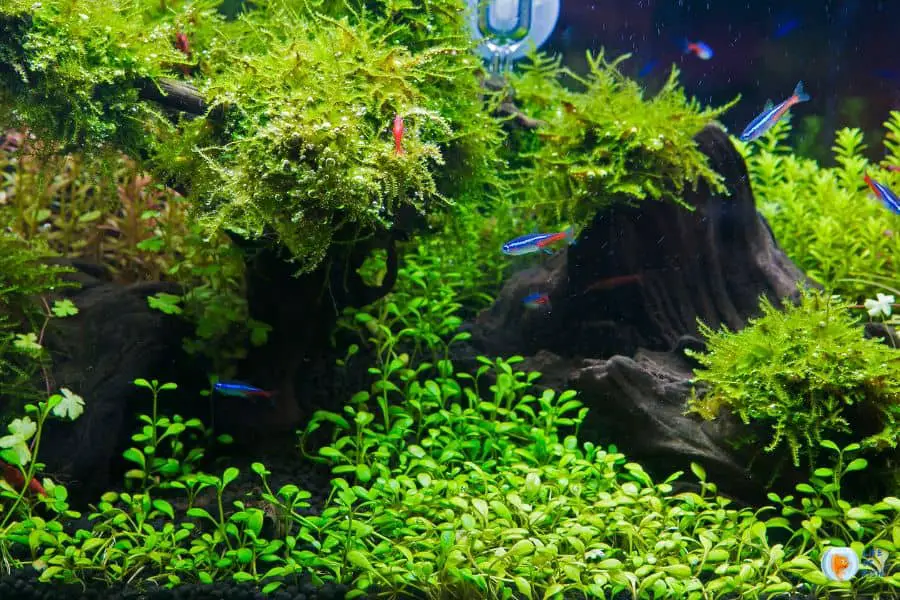
Plant Selection Criteria
When it comes to selecting plants for an aquarium, there are a few things to consider. Firstly, the type of plants being chosen must be suitable for the tank size and water conditions. For example, some larger plants may not thrive in small tanks or hard water.
Secondly, it is important to consider the compatibility of different species of plant when making the selection. Some plants cannot coexist with others due to their growth requirements or incompatibility in terms of colors and textures.
It is also important to choose plants that will not overcrowd the tank, as this can lead to stunted growth or stress on existing fish and other inhabitants. When selecting aquarium plants, it is best practice to get advice from an aquarium expert as they can help identify any potential risks and provide guidance on how many plants should be present in relation to the size of the tank. This will ensure that your aquarium remains healthy and balanced with its inhabitants.
Proper Planting Techniques
When it comes to proper planting techniques, the key is to be aware of the size and shape of each plant. It’s important to position them in such a way that they will have plenty of room to grow and spread out. Here are some tips for successful planting:
- Choose the right substrate for your plants – this is essential for their nutrient intake and health.
- Keep your plants spaced appropriately – if planted too close together, they won’t receive enough light or oxygen and can become overcrowded quickly.
- Be mindful of how large the plants will get when selecting them – this will help prevent overcrowding as well as make it easier to maneuver around your tank later on.
- Don’t forget to fertilize! The right amount of fertilizer can make all the difference in terms of healthy growth and overall success.
It’s also important to remember that different aquarium plants require different amounts of light, water, and CO2, so be sure you understand what each species needs before you purchase it. Keeping these factors in mind when planning out your tank setup will ensure that your plants stay healthy and beautiful for years to come!
Pruning And Maintenance Tips
Now that you have your plants properly planted in your fish tank, it’s time to learn about pruning and maintenance tips. Pruning is important for aquatic plant care because it helps keep the plants healthy and growing in the tank. Plant trimming is also good for maintaining the beauty of the tank. To ensure healthy growth, use pruning techniques such as snipping off dead leaves or removing excess growth from stems or branches.
It’s also important to regularly test your water quality, as this will help maintain a balanced environment for your plants. When testing the water, look for ammonia levels, nitrates and nitrites, pH levels, and carbon dioxide levels. If any of these are too high or too low, take steps to correct them such as adding new aquarium substrate or increasing water flow with a filter system. Finally, be sure to clean out any debris from your aquarium on a regular basis; this will reduce the chances of buildup which can cause health issues in both your fish and your plants.
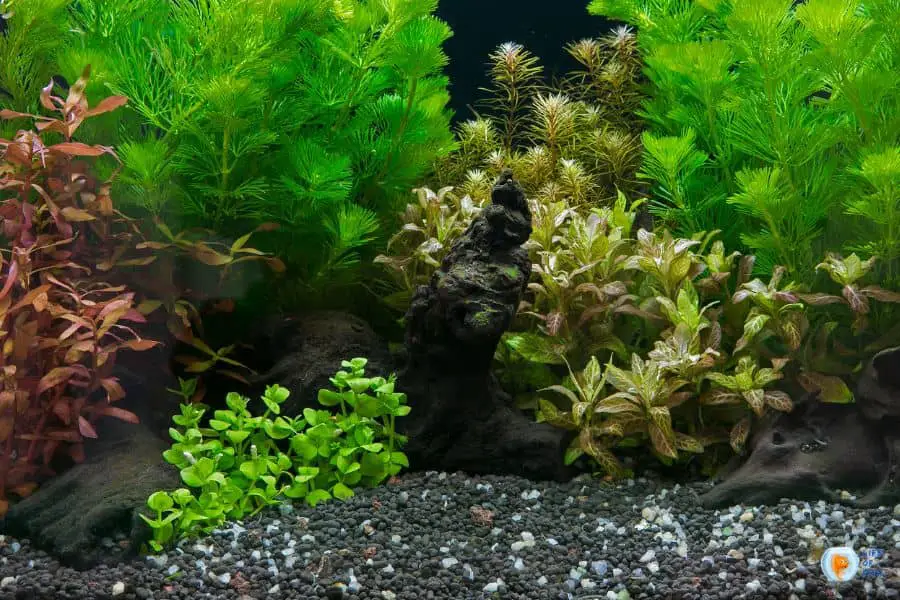
Choosing The Right Number Of Plants
When planning your aquarium layout, it’s important to consider plant selection criteria and the desired nutrient balance for fish health. Too many plants can lead to an imbalance of nutrients, resulting in excessive algae growth. To avoid this, select plants that have varying nutritional requirements and do not overcrowd the tank. Also, take into account the growth rate of each species when deciding how many plants to include in your aquarium.
Compatibility With Other Aquatic Life
When selecting plants for an aquarium, it is important to consider the compatibility of the plants with other aquatic life. Fish and other tank mates can be easily harmed by certain species of plants, so it is important to do research on compatible species. It is also wise to avoid overcrowding the aquarium with incompatible plants, as this can increase the risk of fish being injured or killed.
Incompatible species of plants can cause physical harm to fish or other tank mates, such as sharp leaves that may cut or scratch them. Additionally, some plant species produce toxins that can harm fish if ingested, leading to health problems. Moreover, incompatible plants may interfere with the natural habitat of fish and other aquatic creatures by blocking access to food sources or restricting movement in the water.
It is essential to ensure that all plants in an aquarium are compatible with their inhabitants before adding them to the tank. Research should be done on both compatible plant species and compatible tank mates before buy any new additions into the aquarium environment. This will help create a safe and healthy environment for all aquatic creatures in the tank and will prevent any potential risks posed by incompatible plant species.
Alternatives To Overcrowding
For those seeking to avoid overcrowding their aquarium, there are a variety of alternatives. Plantless aquariums are an option for some, as they rely entirely on natural decorations and artificial decor to create an interesting environment. Additionally, substrate rocks and fish-only tanks can be used to create a unique and beautiful setup without the need for plants.
- Plantless fish tank
- Natural decorations
- Artificial decor
- Substrate rocks
- Fish-only tanks
These options allow for customizing the tank’s look and feel, while avoiding overcrowding. Careful consideration should be taken when selecting these components to ensure that all elements are compatible with each other. Also it will not harm any fish in the tank or cause water chemistry issues from improper use of items such as fake plants or substrate rocks containing copper or other heavy metals that can be toxic to fish.
To ensure compatibility, research is key when selecting any type of ornamentation or substrate material for your tank. With careful planning, it is possible to create an attractive and safe environment for both you and your aquatic animals without overcrowding your fish tank with plants!
Maintaining Balance In The Aquarium
Once you’ve decided on an alternative to overcrowding your aquarium with plants, it’s important to maintain balance in the tank. This means maintaining a balance of water, plants, fish, filter and nutrients. This can be achieved through regular water changes and the addition of certain plant species. For instance, floating plants such as duckweed can be beneficial for fish health by absorbing excess nutrients from the water column.
It’s also important to choose the right type of filter for your tank. A good filtration system should remove debris and uneaten food while not disrupting the natural cycle in the aquarium. Additionally, you may need to supplement your aquarium with additional nutrients such as nitrate and phosphate if levels become too low in order to support the healthy growth of your plants.
By carefully monitoring water parameters and performing regular maintenance tasks such as cleaning filters and performing water changes. You can ensure that all elements remain in balance within your aquarium environment. This will help create a healthy ecosystem where both plants and fish can thrive.
Conclusion
Overcrowding your aquarium with plants can be a beneficial and attractive way to decorate your tank. By understanding the risks, benefits and solutions associated with overcrowding, you can create an attractive, healthy and balanced aquarium with plenty of plants.
When adding plants to your tank, it’s important to know their light requirements and what type of plant you’re adding. Too many or too few plants can have a negative impact on the water quality and other aquatic life in the tank. Additionally, it’s essential to understand how many plants are compatible with the other species living in the tank.
Lastly, there are alternatives available for those who don’t want to overcrowd their tank with too many plants. Artificial decorations such as rocks or driftwood can be used to create an attractive landscape without impacting water quality. With a little research and planning, you can create a stunningly beautiful yet balanced aquarium environment that will be both safe and enjoyable for all of its inhabitants.
Read Next : Signs Of Too Much Light On Aquarium Plants : The Dark Side of Aquarium Lighting
